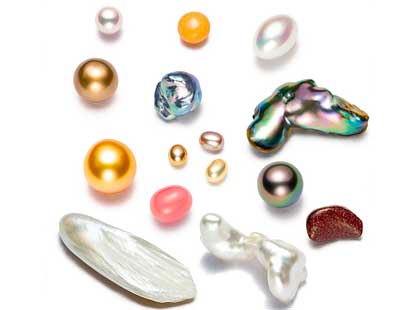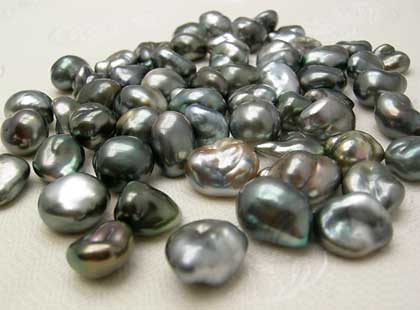Birthstones by the Month
One of the June Birthstones is Pearl
Pearl Natural Form
Typically found in modern wedding jewelry, pearls have been a fashion staple since antiquity. Ancient myth suggests pearls were formed when oysters opened to greet the morning and were given rays of sunshine or dew drops. Elizabeth I and Jackie Kennedy are commonly remembered for their love of pearls. These beautiful materials are found all over the world and on almost every continent, though South Sea pearls have become famous for their high quality.
Pearl Facts
Pearls display a reflective surface referred to as lustre. Lustre is specifically caused by light passing through the layers of nacre and reflecting back from within the pearl. The quicker nacre is produced, the less lustre the pearl will display. Highly lustrous pearls have crisp reflections, some even mirror-like, while lower grade pearls have little or distorted reflections.

Mixed Assortment Of Pearls
This is a great example of the many different types of pearls that can be found. [2]
Pearl Formation
While gems are mined, pearls are instead harvested from oysters and mollusks. Pearls begin life as an irritant to the oyster, most often in the form of sand or broken shell. This foreign object lodges itself inside the soft inner body of the oyster where it becomes stuck. The oyster then begins coating the irritant with nacre to make it smooth. As long as the foreign object remain inside the oyster, nacre will continue to be produced. Nacre is comprised of microscopic crystals of calcium carbonate which align in a way so light passing through each crystal is refracted by another, resulting in the lustrous shine and color of the pearl. Today, pearls found in nature are far less common than the ones found at pearl farms called cultured pearls. Instead of oysters accidently coming into contact with a foreign object, pearl farmers insert sand or a small shell into the mollusk to begin the process.

Black Pearl And Its Shell
A black pearl and a shell of the black-lipped pearl oyster. The iridescent colors originate from nacre layers. [3]
The characteristics of Pearl
Pearls are quite soft, only rating from a 2.5 to 4 on the Mohs hardness scale. Depending on a range of factors including where the mollusk is from, the irritant and more, colors of Pearls can include white, pink, silver, cream, gold, green, blue and black all with translucent or opaque surfaces.
Cut and Clarity for the June birthstone
Since Pearls are already in their final form, it is highly unlikely to see a cut pearl. Pearls are typically divided into spherical, symmetrical or baroque shapes. Within these three categories there are seven widely recognized shapes: round, near-round, semi-round, oval, button, drop, baroque and semi-baroque which are occasionally called varying names in the jewelry and fashion industries. Shapes are determined inside the pearl by the original shape of the irritant and position of the irritant inside the mollusk.

Tahitian Keshi Pearls
Keshi pearls are small non-nucleated pearls formed as a by product of pearl cultivation. [4]
The value of Pearl
Pearls are valued for their lustrous shine, smooth round shape and large size. Since it takes a great amount of time for an oyster to produce a perfectly round large pearl, these large varieties are increasingly rare and expense goes up. Perfectly round pearls are exceptionally rare and therefore the most valuable. Value is also increased by even coloring of the nacre and highly reflective luster.
Is Pearl ever treated?
There are a number of ways to treat pearls including, irradiation, bleaching, heating, filling and waxing. Bleaching is a common practice even with higher grade pearls. Lower-grade Pearls are often dyed with silver nitrate or organic dyes to darken the nacre, processed with irradiation to darken the nucleus of the pearl and subsequent layers as well heating where the pearl is heated and cooled to enhance luster. Trends in jewelry also call for highly dyed Pearls where there the natural color does not matter. These Pearls are dyed in metallics, neons, pastels and more.
More about Pearl the June birthstone
Pearls are quite soft and should be handled delicately regardless of treatment or not. Never place pearls in ultrasonic cleaners or steamers. Use only a soft cloth with mild soap and water. Make sure the pearls or, if in jewelry, the entire piece is completely dry before storing or wearing. It is recommended to put pearls on only after applying hair products or perfumes as these can cause adverse effects over time.
The American Gem Society's June Birthstone page has more information to help you buy from knowledgeable and skilled jewelers and to help you make the most informed buying decision.
Image Attribution
- By Hannes Grobe/AWI (Own work) [CC-BY-3.0], via Wikimedia Commons
- By MASAYUKI KATO (MASAYUKI KATO's file) [GFDL or CC BY-SA 3.0], via Wikimedia Commons
- By Brocken Inaglory (Own work) [GFDL or CC BY-SA 3.0], via Wikimedia Commons
- By Jennifergaglione (Own work) [CC0], via Wikimedia Commons
- By Jennifergaglione (Own work) [CC0], via Wikimedia Commons

